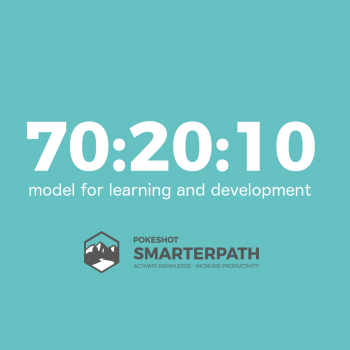
Employees learn 70% of their knowledge on the job – How SmarterPath supports you strategically
An article by Sandra Brückner, Chief Product Officer of SmarterPath, after 2016 Learntec:
On the train ride back from the 2016 Learntec, something particularly interesting caught my attention –
Jochen Robes’s presentation on the 70-20-10 rule in a modern learning society. He calls for a transformation of corporate learning because learning, whether it be social learning or e-learning, is not just about conveying knowledge but rather developing skills and competencies. For what good is it if learners know something, but can’t apply this knowledge in practice?
Companies need to do a radical rethink (from courses to campaigns), which entails learning being integrated into employees’ daily work routines. Learning management (LM) systems that are only designed to impart formal knowledge are mostly a huge waste of time. As far back as 1885, Hermann Ebbinghaus already discovered that people forget 60 percent of what they learned within just 20 minutes. And what about after 40 or even 60 minutes? And is this always the case? I see it as a company’s responsibility to ensure that as little knowledge as possible falls into the “I-once-attended-a-course” category.
In his presentation, Robes calls for a shift away from structures consisting of courses, learning platforms, passive participants, and training instructors toward new models comprised of campaigns, learning environments, interactive participants, and community managers. Companies should make efforts to support the search for information (learning environment) and enable learners (interactive participants) to take part directly in the knowledge discovery process. For it is only possible to turn knowledge into skills and competencies if there is an interplay between hands-on learning, the exchange of information and ideas with others, and a balanced continuing education and training program. The biggest change here involves the role of training instructors. It is no longer their job to stand in front of the classroom and share their knowledge; instead, they now assume more the role of a community manager. On the strength of their experience, they attract learners and motivate them to participate, while also moderating discussions, sharing their expertise and making efforts to convince other learners of the topic’s importance.
But shouldn’t all activities in a company be given equal weight? The 70-20-10 rule serves as a rough benchmark. Robes summarizes the studies on this topic as follows:
- 70 percent of all learning activities take place on the job in daily work processes (experience)
- 20 percent in the exchange of information and ideas with others such as managers and colleagues (exposure)
- 10 percent in continuing education and training programs (education)
Taking into account the 70-20-10 rule and the frightening 60-percent-in-20-minutes finding, I have tried to transform what I have learned into real-world competence by taking a closer look at our social learning solution SmarterPath using these very same criteria.
70 percent: That’s precisely the goal we are striving for with our SmarterPath approach. This means moving away from external LM systems to the incorporation of learning and knowledge processes into a company’s daily work. Here we help our clients with the identification and implementation of relevant use cases and with the integration of SmarterPath into their employees’ work routines.
20 percent: The motto here is from person to person. You can’t size up employees’ skills and competencies by simply reading their profile. Interaction takes place in modern channels where sharing and the joint creation of content play a major role.
10 percent: Continuing education and training offerings are not only realizable using SmarterPath, but most importantly can be linked to the 70- and 20-percent learning components. Employees share experiences with and knowledge of a topic, and the company supports this exchange with a targeted online course on this very topic. This is how companies can create an optimal learning environment.
SmarterPath by itself, however, can only provide the basis for a company-wide 70-20-10 strategy. Companies have to build on this foundation and makes decisions in the following areas:
- What type of content should I provide to learners and in what form should it be available (microlearning)?
- What use cases do I want to implement?
- How do I transform my training instructors into community managers?
- How do I promote the sharing of experiences and knowledge among employees in the online world?
Robes’s presentation reinforced my impression from the Learntec that we are on the right track with the SmarterPath approach – promoting social learning, connecting people, and helping our clients implement their individual 70-20-10 strategy.
Source: Jochen Robes, Das 70:20:10-Modell – Lernen am Arbeitsplatz neu entdecken (The 70-20-10 Model – Rethinking Learning at the Workplace)
For more information please visit our website or download our brochure. We would like to show you the advantages and functions of SmarterPath personally in a demo too.
1 thought on “Employees learn 70% of their knowledge on the job – How SmarterPath supports you strategically”
Comments are closed.